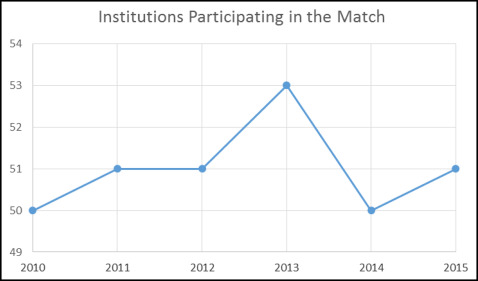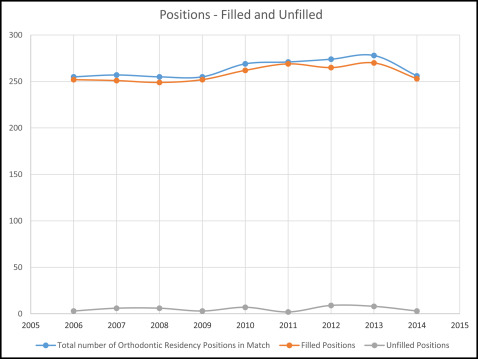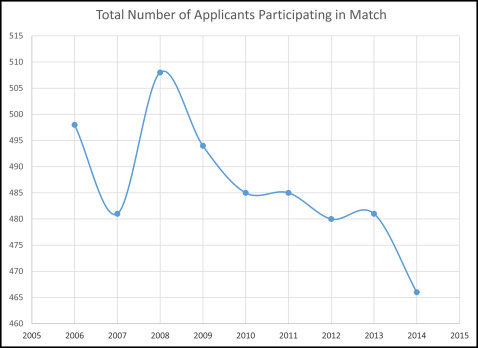Introduction
The National Matching Service provides an ethical and unbiased selection process between residency programs and candidates. Currently, 51 of the 66 accredited orthodontic residency programs in the United States participate in the matching service for orthodontic programs (the Match), and 15 do not. Our purpose was to identify the factors that contribute to an orthodontic residency program’s decision to participate in the Match program or to refrain from doing so.
Methods
A survey was sent to 64 orthodontic programs regarding their perception of the Match. A qualitative content analysis of the survey responses was conducted. Common recurring themes were identified. Simple descriptive statistics were used to summarize the data.
Results
Fifty-six programs responded to the survey. Survey content analysis showed 2 prevailing themes: orthodontic programs participate in the Match because they believe it is a fair process, or they refrain from participating so that they can pressure selected candidates to accept positions early.
Conclusions
Participation in the Match benefits candidates, schools, and orthodontic education in general. Candidates can interview at multiple schools and rank their choices without the pressure of early acceptance. Orthodontic programs are forced to compete for strong candidates; this ultimately strengthens the education their residents receive. The Match can accommodate complex requirements of different programs, including allowing them to recruit a certain mix or a diversity of students. We concluded that all orthodontic residency programs in the United States should participate in the Match.
Highlights
- •
The Match program benefits candidates and orthodontic programs.
- •
Candidates can interview at various programs and make an informed ranking.
- •
It is flexible and accommodates complex requirements from each program.
- •
It benefits orthodontic programs by leveling the playing field.
- •
Our specialty should encourage non-Match programs to participate.
The future of our specialty rests in our orthodontic residency programs. The future of our residency programs rests in their ability to recruit and educate outstanding candidates. Good competition for candidates results when program directors and department faculty strive to strengthen the educational experience provided to their residents. This creates a domino effect: improved educational experience of residents enhances the reputation of the program and the program’s ability to recruit great candidates. Macroscopically, if all programs competed this way, it would strengthen our specialty and elevate the quality of orthodontic care rendered to our patients. Bad competition for candidates results when programs gain an edge in recruitment by pressuring candidates to accept positions earlier than do other programs. Candidates, eager to secure a slot in an orthodontic department, feel pressured to accept early offers before they have time to evaluate other programs. If all programs competed this way, the strength of our specialty would gradually decline, along with the quality of patient care.
This problem is not unique to our specialty, and it led to the development of the National Resident Matching Program in 1952 to assist medical programs. The services were extended to postdoctoral dental programs in 1985 (the Match). The Match process is as follows: candidates apply to multiple orthodontic residency programs based on their interests; from that pool of applicants, programs select those they wish to interview. After the interviews, the candidates and the programs rank each other and submit their rank order lists to the National Matching Service (NMS). The NMS uses a “best fit” optimization algorithm to match candidates to programs and releases the results, usually by early December. If strictly adhered to, the Match allows for an ethical and unbiased selection process based on mutual interests shared between the applicant and the residency program of choice. In dentistry, the Match is currently used by programs in advanced education in general dentistry, general practice residency, oral and maxillofacial surgery, orthodontics, pediatric dentistry, and dental anesthesiology. Even though the Match is partly sponsored by the American Association of Orthodontists and endorsed by the American Dental Education Association, not all orthodontic residency programs participate.
The perception of residents and program directors toward the admission process has been assessed in other dental specialties, and an earlier survey determined the factors that influence the rank order lists provided by applicants applying to orthodontic residency programs and the resulting differences in the applicants’ needs and varied perceptions. However, there is a dearth of information about the factors that influence the participation of orthodontic residency programs in the Match. Our purpose was to identify these factors.
Material and methods
Information on the NMS, orthodontic program participation in the Match, and the characteristics of orthodontic programs was obtained from publicly available sources such as the NMS Web site, the American Association of Orthodontists Accredited Orthodontic Programs Web site, and the individual orthodontic programs’ Web sites.
A survey was designed by a focus group of full-time orthodontic faculty members and orthodontic residents to capture the perceptions of Match participation by orthodontic residency program directors. This survey included the following open-ended questions.
- 1.
What is the annual number of orthodontic residents accepted into your program?
- 2.
Does your orthodontic residency program participate in the Orthodontics Residency Matching Program?
- 3.
If your program participates in the Orthodontics Residency Matching Program, what are your reasons for participating?
- 4.
If your program does not participate in the Orthodontics Residency Matching Program, what are your reasons for not participating?
- 5.
In your view, what are the advantages of participating in the Orthodontics Residency Matching Program?
- 6.
In your view, what are the disadvantages of participating in the Orthodontics Residency Matching Program?
- 7.
Do you think that all orthodontic residency programs should participate in the Orthodontics Residency Matching Program? Why or why not?
- 8.
Do you intend to participate in the Orthodontics Residency Matching Program for the upcoming year?
- 9.
Should all programs (Match and non-Match) notify candidates of acceptance on the same date?
Institutional review board exempt status was granted by the Human Subjects Protection Office at the College of Dentistry and Dental Clinics of the University of Iowa. The protocol numbers are 201410808 (phase I) and 201501791 (phase II).
In the United States, 66 orthodontic residency programs are accredited by the Commission on Dental Accreditation. The survey was sent by e-mail to 64 programs. The survey was not sent to the University of Iowa (the authors’ school and a Match participant) or to the Tri-Services orthodontic residency program (because it is part of the United States military). To encourage participation in the survey, up to 4 e-mails were sent to program directors over a period of 4 weeks. These requests were followed by personal phone calls from the authors to all program directors who did not respond to the e-mails. Of the 64 programs contacted, 50 participate in the Match, and 14 do not. A total of 56 programs responded to the survey. One program declined to participate, and 7 did not respond to the e-mails or phone calls. Forty-four of the 50 programs that currently participate in the Match responded to the survey (response rate, 88%), and 12 of the 14 programs that do not participate in the Match responded to the survey (response rate, 86%).
Statistical analysis
All survey responses were reviewed by 2 investigators (V.A. and T.E.S.). A qualitative content analysis of the open-ended questions in the survey was conducted. Common recurring themes were identified and are presented here. Simple descriptive statistics were used to summarize the data. Since this study was designed to be qualitative, no tests of association were performed.
Results
Of the 66 accredited orthodontic residency programs in the United States, 51 participate in the Match, and 15 did not (as of October 22, 2014, for the academic year 2015-2016). The characteristics of these programs are summarized in Table I . Furthermore, 278 of 383 orthodontic residency positions (72.6%) were filled by the Match. The mean number of resident positions in a program that participated in the Match was 5.4 (compared with an average of 7 resident positions in programs that do not participate in the Match).
| Measure | Do not participate in the match (n = 15) | Participate in the match (n = 51) |
|---|---|---|
| Total number of positions | 105 | 278 |
| Mean | 7 | 5.4 |
| Standard deviation | 4.1 | 2.7 |
| Minimum | 2 | 1 |
| 25th percentile | 4 | 4 |
| Median | 6 | 5 |
| 75th percentile | 10 | 7 |
| Maximum | 15 | 16 |
Recent trends in the number of institutions participating in the Match, trends in total positions (filled and unfilled) of programs that participate in the Match, and trends in total numbers of applicants who were registered in the Match service are summarized in Figures 1-3 . As illustrated, the total number of institutions participating in the Match during 2014 decreased compared with the previous 2 years. Overall, from 2006 to 2014, the vast majority of the residency positions in programs participating in the Match were filled. During the same time period, the total number of applicants registered in the Match declined.



Several reasons quoted by program directors for their participation in the Match were (1) recommended by the American Association of Orthodontists, (2) fair process for applicants because they are not pressured to join a program before interviewing at other programs, and (3) fair process for all institutions because of less pressure on program directors to accept legacy applicants.
An overwhelming proportion of program directors thought that participating in the Match was the “right way of doing it.” All program directors mentioned that they intend to participate in the Match for the upcoming year.
The following reasons were given by non-Match program directors for not participating in the Match: (1) to have more autonomy in the choice of applicants who best fit their program and thus have more control over the class composition, (2) to minimize the risk for an open “unfilled” position, (3) to maximize the chance of having “top students” in their program, (4) to match programs with unique requirements (eg, linguistic preference), and (5) to avoid the perception that the Match is too restrictive or convoluted.
None of the non-Match program directors expressed intent to participate in the Match in the upcoming year. The advantages and disadvantages of the Match quoted by the Match and non-Match participating program directors are listed in Table II .
| Advantages cited by Match participants | Disadvantages cited by Match participants | Advantages cited by non-Match participants | Disadvantages cited by non-Match participants |
|---|---|---|---|
| Centralized and streamlined application process wherein the programs and applicants rank their preferences | Since all orthodontic residency programs do not participate in the Match, the entire process is “undermined,” and programs that do not participate in Match can “cherry pick” applicants | Potentiates the placement of applicants with a strong academic record in a program they perceive to fit best | Perception that matching program has areas of unethical behavior |
| Less pressure and easier for applicants, since they can make an informed decision on prioritization of programs and consolidate their rank order list according to their preference | Lack of control over which applicants match their program | “Perception” of fairness to the student | Not knowing the composition of the class |
| Can get a wider pool of applicants by participating in the Match | Applicants must incur the expenses of interviewing at multiple programs; expensive for applicants when they interview at multiple programs | Better control of the time process | “The Match process and conditions may be sound on paper; however, several mitigating factors play a role in selecting applicants” |
| Provides a binding ethical agreement between the applicants and the programs | “Bird-in-hand” dilemma for applicants because of nonparticipation of certain orthodontic programs | Prevent “legacy” appointments | Less-established programs may have difficulty filling positions |
| Most program directors stated that participating in the Match was “right and honorable” | Perception that certain orthodontic programs are not compliant with NMS rules and agreement | Easier to schedule |
Stay updated, free dental videos. Join our Telegram channel

VIDEdental - Online dental courses


